Mosquitoes are insect species belonging to the order (Diptera). Unlike other species under this order, there are small scales on mosquito wings. A female mosquito has got a long mouth functioned as blood-sucking proboscis. A male mosquito has bushy antennae and does not have a sucking proboscis like a female. They mainly feed on nectar or sweet sources such as sugar.
According to statistics by scientists, there are around 2,500 different species worldwide. Mosquitoes trouble and hinder human rest as well as work. They attack livestock and pets, making them grow slowly, catching disease and milking badly etc. More seriously, some mosquito species transmit extremely harmful human diseases such as malaria, dengue, yellow fever, filariasis, encephalitis or be vectors of West Nil River virus for human and livestock …
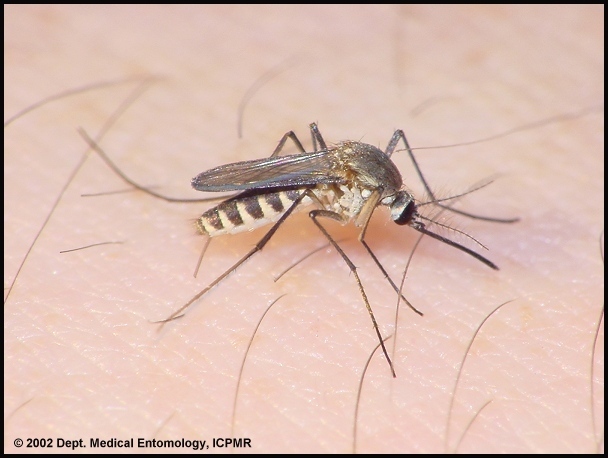
(A mosquito sucking human blood)
Life cycle and biological characteristics of mosquitoes
Mosquitoes go through four stages in their life cycle: egg, large, pupa and imago. Every stage can easily be identified by very specific characteristics.
Eggs
In some species, eggs form layers called “rafts” that float on the water with each raft consisting of 100 - 300 eggs. Such rafts seem to be dirty scum floating on the water. Some other species of Anopheles drop eggs singly without forming rafts. Some species (Culex, Culiseta, Anopheles) lay eggs on the water while other species (Aedes, Ochlerotatus) lay eggs on humid surface near the water’s edge. Every female mosquito can lay one raft of egg every three nights during their life cycle. Most of eggs will be hatched out to become larvae within 24 - 48 hours. Eggs of some species can survive in the temperature under 0oC in the winter, then hatched out in warm weather or some eggs can survive in drought and hatched out in water (such as Aedes và Ochlertatus). Water is a key condition to our life. Most of mosquito species often lay eggs on clean water or places containing water such as cisterns, vessels, cans, flowerpots, swimming-pools, broken pots, swamps … Remarkably, mosquitoes like laying eggs on stagnant water hidden by trees from light and wind.
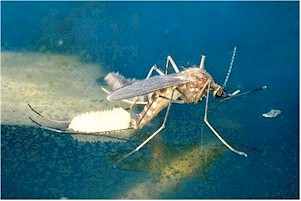
(A mosquito lays eggs)
Larvae
Larvae often live in the water from 4-14 days up to the temperature. During the course of living in the water, they must come to the water surface frequently to breathe. Most of larvae hang themselves upside down near the surface and have got siphon to stick out of the water to breathe. Larvae of Anopheles mosquitoes have no siphon, therefore, they have to lay on the surface to breathe. Some other species stick to tree-trunks living in the water to get oxygen. In this stage, larvae need much more food such as micro organism, organic components like seaweed, ephemerous creatures, fungus, bacteria etc. Toxorhynchites larvae with large-sized body eat larvae of other mosquito species. Larvae develop through four stages. At the end of each instar, the larvae molt, shedding their skins to allow for further growth. In the fourth instar, they metamorphose into pupae.
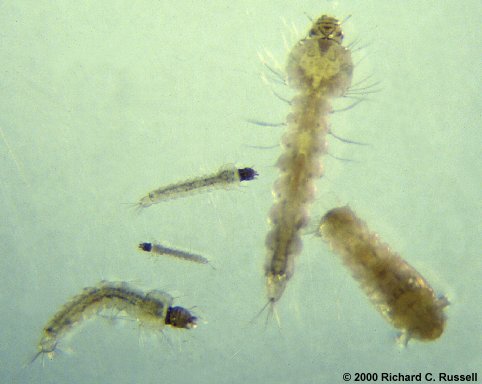
(Mosquito larvae)
Pupae
In this stage, larvae just rest and do not feed but still move. By flipping abdomen or lashing tail, pupae can swim down the water bottom or move to a safer place. Pupae are lighter colored than water. They must come to the surface frequently to breathe, which they do through a pair of respiratory trumpets. This is the stage for developing to become adults. The duration depends on species and circumstances, for example, for Culex species in the summer, pupa stage last 2 days. Generally, pupa stage often last from 1-4 days. When completely-grown, adult mosquitoes break pupa cover to come out.
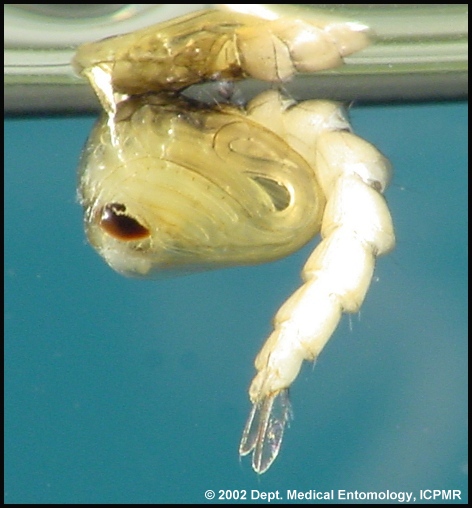
(Mosquito pupa)
Adult
Just after emerging from the pupal stage, the body is still weak, an adult mosquito must stay at the water surface in a short time until its body becomes strong and its wings open wide and get dry enough to fly away. After few days of emerging from the pupal stage, adult mosquitoes do not have needs of sucking blood or mating.
Only female mosquitoes need to suck blood for their food source. Male mosquitoes do not suck blood but use nectar or other sweet food sources to exist.
Adult mosquitoes fly strongly, for example, species like Aedes or Ochlerotatus can fly far from their birthplace up to tens of kilometers. However, most of them like hovering about places where human beings and livestock live or comon residence. Just in favorable weather or in need of finding place to lay eggs, they move far.
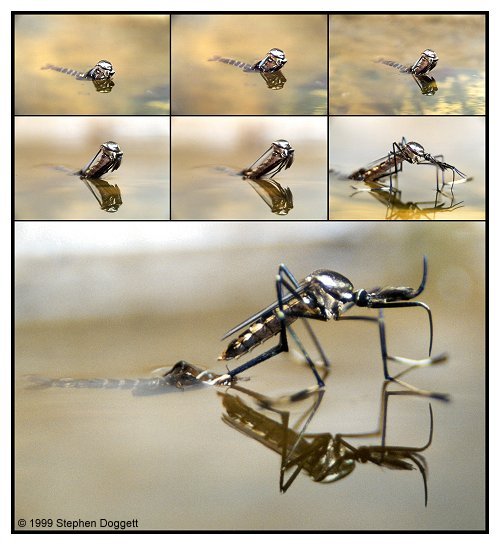
(The stage of becoming adult mosquitoes)
Favorite period of sucking blood for food depends on mosquito species. For example, Aedes and Ochlerotatus species often hunts for food early in the morning or at twilight. Culex species usually sucks human blood at twilight or at night. Culiseta species attacks human at night. Anopheles species attacks human in the most venturesome and persistent way. This is also the only species of transmitting malaria to human beings etc.
The period of development from egg to adult varies among species and is strongly influenced by ambient conditions (maybe from 10 – 14 – 20 – 30 days). One common rule is that in favorable ambient conditions (warm, humid and sufficient food etc.), the period of development for a cycle will be shortened.